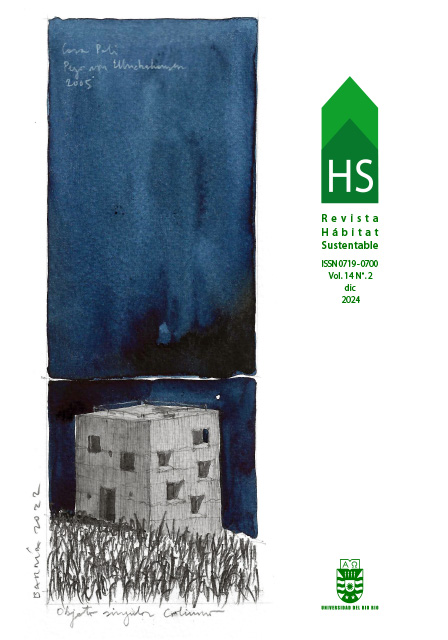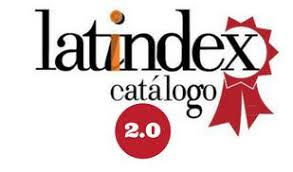Potencial de um sistema de baixo custo para medir a qualidade ambiental interior em climas extremos da América Latina visando a equidade energética
DOI:
https://doi.org/10.22320/07190700.2024.14.02.06Palavras-chave:
sistema de medição ambiental, sensores de baixo custo, qualidade ambiental interna, medição de poluentesResumo
A saúde pública apresenta desafios multidisciplinares que envolvem uma combinação de bem-estar físico, mental e social. Duas limitações para a quantificação de poluentes internos (gases, compostos químicos e partículas em suspensão) são o alto custo e a complexidade dos sistemas de medição disponíveis. Neste cenário, uma abordagem experimental foi utilizada para desenvolver um sistema de baixo custo para medir variáveis que afetam a saúde humana e ambiental. Os processos de calibração, validação e ajuste técnico foram realizados em um local de clima extremo no sul do México, seguindo padrões nacionais e internacionais. Os principais resultados mostraram a viabilidade do uso de ferramentas de baixo custo para medir poluentes em países em desenvolvimento. 57% dos dados relativos ao H2S tiveram um resultado acima de 150 ppm, o que é considerado prejudicial à saúde humana. Por outro lado, o desenvolvimento do sistema de medição na localidade estudada mostrou a importância de contar com dados para medir os níveis de poluição ambiental de acordo com os hábitos e costumes de cada região. Foram utilizados sensores e sistemas de acesso aberto, pois podem beneficiar diretamente pesquisadores com recursos limitados e os setores público e privado interessados em medir variáveis ambientais e de conforto para promover o acesso universal ao conhecimento.
Downloads
Referências
AFROZ, R., GUO, X., CHENG, C.-W., DELORME, A., DURUISSEAU-KUNTZ, R., & ZHAO, R. (2023). Investigation of indoor air quality in university residences using low-cost sensors. Environmental Science: Atmospheres, 3(2), 347–362. https://doi.org/10.1039/d2ea00149g
ASHRAE. (2024, March 6). Indoor Air Quality Guide. ASHRAE. https://www.ashrae.org/technical-resources/bookstore/indoor-air-quality-guide
BALZA, L., CASTRO VARGAS, S., GÓMEZ PARRA, N., JIMENEZ MORI, R. A., MANZANO, O., & SEREBRISKY, T. (2024). Does Income Growth in Latin America and the Caribbean Drive Disproportionate Energy Consumption? IDB. https://doi.org/10.18235/0012883
BURBANK, A. J., HERNANDEZ, M. L., JEFFERSON, A., PERRY, T. T., PHIPATANAKUL, W., POOLE, J., & MATSUI, E. C. (2023). Environmental justice and allergic disease: A Work Group Report of the AAAAI Environmental Exposure and Respiratory Health Committee and the Diversity, Equity and Inclusion Committee. Journal of Allergy and Clinical Immunology, 151(3), 656–670. https://doi.org/10.1016/j.jaci.2022.11.025
COWELL, N., CHAPMAN, L., BLOSS, W., SRIVASTAVA, D., BARTINGTON, S., & SINGH, A. (2022). Particulate matter in a lockdown home: evaluation, calibration, results and health risk from an IoT enabled low-cost sensor network for residential air quality monitoring. Environmental Science: Atmospheres, 3(1), 65–84. https://doi.org/10.1039/d2ea00124a
DABANLIS, G., LOUPA, G., TSALIDIS, G. A., KOSTENIDOU, E., & RapSOMANIKIS, S. (2023). The Interplay between Air Quality and Energy Efficiency in Museums, a Review. Applied Sciences, 13(9), 5535. https://doi.org/10.3390/app13095535
Environmental Protection Agency. (2022). Criteria Air Pollutants. NAAQS Table. https://www.epa.gov/criteria-air-pollutants/naaqs-table
ENYOH, C. E., VERLA, A. W., QINGYUE, W., OHIAGU, F. O., CHOWDHURY, A. H., ENYOH, E. C., CHOWDHURY, T., VERLA, E. N., & CHINWENDU, U. P. (2020). An overview of emerging pollutants in air: Method of analysis and potential public health concern from human environmental exposure. Trends in Environmental Analytical Chemistry, 28, e00107. https://doi.org/10.1016/j.teac.2020.e00107
FREDERICKSON, L. B., RUSSELL, H. S., FESSA, D., KHAN, J., SCHMIDT, J. A., JOHNSON, M. S., & HERTEL, O. (2023). Hyperlocal air pollution in an urban environment - measured with low-cost sensors. Urban Climate, 52. 101684. https://doi.org/10.1016/j.uclim.2023.101684
GARCIA, M. RAMÍREZ, H., ULLOA, H., GARCÍA, O., MEULENERT, A., & ALCALÁ, J. (2013). Concentración de contaminantes SO2 , NO2 y correlación con H, SO4 y NO3 durante la temporada de lluvias en la Zona Metropolitana de Guadalajara , Jalisco , México. Revista Chilena de Enfermedades Respiratorias., 29(2), 81–88.
GANGWAR, M., JAMAL, Y., USMANI, M., WU, C.-Y., & JUTLA, A. S. (2024). Carbon dioxide as an indicator of bioaerosol activity and human health in K-12 school systems: a scoping review of current knowledge. Environmental Research: Health, 2(1), 012001. https://doi.org/10.1088/2752-5309/ad1c41
GINEBREDA, A., & BARCELÓ, D. (2022). Data-based interpretation of emerging contaminants occurrence in rivers using a simple advection-reaction model. Water Emerging Contaminants & Nanoplastics, 1(3), 12. https://doi.org/10.20517/wecn.2022.07
JUNG, C. R., NISHIHAMA, Y., NAKAYAMA, S. F., TAMURA, K., ISOBE, T., MICHIKAWA, T., IWAI-SHIMADA, M., KOBAYASHI, Y., SEKIYAMA, M., TANIGUCHI, Y., & YAMAZAKI, S. (2021). Indoor air quality of 5,000 households and its determinants. Part B: Volatile organic compounds and inorganic gaseous pollutants in the Japan Environment and Children’s study. Environmental Research, 197. 111135. https://doi.org/10.1016/j.envres.2021.111135
KALIA, P., & ANSARI, M. A. (2020). IOT based air quality and particulate matter concentration monitoring system. Materials Today: Proceedings, 32(3), 468–475. https://doi.org/10.1016/j.matpr.2020.02.179
KHALIL, N. A., & KAMOONA, G. M. I. (2022). The Effect of Indoor Air Quality in University Classrooms on the Immunity of Its Occupants. International Journal of Sustainable Development and Planning, 17(8), 2453–2461. https://doi.org/10.18280/ijsdp.170813
KIM, S., & SOHANCHYK, G. (2022). Exploring Children’s Engagement in Monitoring Indoor Air Quality: Longitudinal Study. JMIR Formative Research, 6(1), e32404. https://doi.org/10.2196/32404
KOENGKAN, M., POVEDA, Y. E., & FUINHAS, J. A. (2020). Globalisation as a motor of renewable energy development in Latin America countries. GeoJournal, 85(6), 1591–1602. https://doi.org/10.1007/s10708-019-10042-0
MENTESE, S., MIRICI, N. A., ELBIR, T., PALAZ, E., MUMCUOĞLU, D. T., COTUKER, O., BAKAR, C., OYMAK, S., & OTKUN, M. T. (2020). A long-term multi-parametric monitoring study: Indoor air quality (IAQ) and the sources of the pollutants, prevalence of sick building syndrome (SBS) symptoms, and respiratory health indicators. Atmospheric Pollution Research, 11(12), 2270–2281. https://doi.org/10.1016/j.apr.2020.07.016
Ministry of Environment and Natural Resources. (2024, April 4). National Air Quality Information System. Monitoring Network SDS01. https://sinaica.inecc.gob.mx/
National Institute of Public Health. (2022). Environment and Health. https://www.insp.mx/
NICHOLAS J. V., & WHITE D. R. (2001). Calibration. In Traceable Temperatures (pp. 159–201). John Wiley & Sons, Ltd. https://doi.org/https://doi.org/10.1002/0470846151.ch5
NILANDITA, W., MUNFARIDA, I., RATODI, M., RATRI NURMANINGSIH, D., & SUPRAYOGI, D. (2019). The Indoor Air Quality in Laboratory Buildings. A Case Study in Integrated Laboratory of UIN Sunan Ampel Surabaya. KnE Social Sciences. 3(21), 873-882. https://doi.org/10.18502/kss.v3i21.5018
NUGROHO, A. P., OKAYASU, T., HORIMOTO, M., ARITA, D., HOSHI, T., KUROSAKI, H., YASUBA, K., INOUE, E., HIRAI, Y., MITSUOKA, M., & SUTIARSO, L. (2016). Development of a Field Environmental Monitoring Node with Over the Air Update Function. Agricultural Information Research, 25(3), 86–95. https://doi.org/10.3173/air.25.86
NURHISANAH, S., & HASYIM, H. (2022). Environmental health risk assessment of sulfur dioxide (SO2) at workers around in combined cycle power plant (CCPP). Heliyon, 8(5), e09388. https://doi.org/10.1016/j.heliyon.2022.e09388
Occupational Safety and Health Administration (OSHA). (2024, March 6). Hydrogen Sulfide. OSHA. https://www.osha.gov/hydrogen-sulfide
Occupational Safety and Health Administration (OSHA). (2015). Indoor air quality in commercial and institutional buildings. 1–32. https://www.osha.gov/sites/default/files/publications/3430indoor-air-quality-sm.pdf
ORTIZ SALVADOR, E. G., RICOY ZÁRATE, E. G., CARRETO HERNÁNDEZ, L. G., SOTELO RODRIGUEZ, P., MOYA ACOSTA, S. L., & CAMPOS AMEZCUA, R. (2022). Numerical and Experimental Study of Cross Ventilation in a Room of a House in the State of Morelos, EasyChair Preprint, 9209. https://easychair.org/publications/preprint/slwnP
QUAH, S. (Ed). (2021). American Society of Heating, Refrigerating and Air-Conditioning Engineers. International Encyclopedia of Public Health (Second Edition, Vol. 2, Issue 1, pp. 56-57). https://doi.org/10.1016/0140-7007(79)90114-2
Red Universitaria de Observatorios Atmosféricos. (2023). Observatorio Atmosférico Mérida. https://www.ruoa.unam.mx/index.php?page=estaciones&id=8
Secretaría de Medio Ambiente y Recursos Naturales. (2024, March 7). NOM-081-SEMARNAT-1994. Límites Máximos Permisibles de Emisión de Ruido de Las Fuentes Fijas y Su Método de Medición. https://biblioteca.semarnat.gob.mx/janium/Documentos/Ciga/agenda/PPD02/081.pdf
Secretaría de Salud. (2019). NOM-022-SSA1-2019 Salud ambiental. Criterio para evaluar la calidad del aire ambiente, con respecto al dióxido de azufre. https://www.dof.gob.mx/nota_detalle.php?codigo=5568395&fecha=20/08/2019#gsc.tab=0
Secretaría de Salud. (2021a). NOM-020-SSA1-2021 Criterio para evaluar la calidad del aire ambiente, con respecto al ozono. https://dof.gob.mx/nota_detalle.php?codigo=5633956&fecha=28/10/2021#gsc.tab=0
Secretaría de Salud. (2021b). NOM-021-SSA1-2021 Criterio para evaluar la calidad del aire ambiente, con respecto al monóxido de carbono. https://www.dof.gob.mx/nota_detalle.php?codigo=5634084&fecha=29/10/2021#gsc.tab=0
Secretaría de Salud. (2021c). NOM-026-SSA1-2021 Criterio para evaluar la calidad del aire ambiente, con respecto al plomo. https://www.dof.gob.mx/nota_detalle.php?codigo=5634085&fecha=29/10/2021#gsc.tab=0
Secretaría de Salud. (2022a). NOM-023-SSA1-2021 Criterio para evaluar la calidad del aire ambiente, con respecto al dióxido de nitrógeno. https://dof.gob.mx/nota_detalle.php?codigo=5633854&fecha=27/10/2021#gsc.tab=0
Secretaría de Salud. (2022b). NOM-025-SSA1-2014 Valores límite permisibles para la concentración de partículas suspendidas. https://www.dof.gob.mx/nota_detalle.php?codigo=5357042&fecha=20/08/2014#gsc.tab=0
Sistema Meteorológico Nacional. (2020). Climatic conditions. https://smn.conagua.gob.mx/es/climatologia/informacion-climatologica/normales-climatologicas-por-estado
TANG, R., & PFRANG, C. (2023). Indoor particulate matter (PM) from cooking in UK students’ studio flats and associated intervention strategies: evaluation of cooking methods, PM concentrations and personal exposures using low-cost sensors. Environmental Science: Atmospheres, 3(3), 537–551. https://doi.org/10.1039/d2ea00171c
TRAN, V. VAN, PARK, D., & LEE, Y.-C. (2020). Indoor Air Pollution, Related Human Diseases, and Recent Trends in the Control and Improvement of Indoor Air Quality. International Journal of Environmental Research and Public Health, 17(8), 2927. https://doi.org/10.3390/ijerph17082927
World Health Organization. (2021). Global Air Quality Guidelines 2021. 1–16. https://iris.who.int/bitstream/handle/10665/345329/9789240034228-eng.pdf?sequence=1
Downloads
Publicado
Como Citar
Edição
Secção
Licença
Direitos de Autor (c) 2024 Claudia Eréndira Vázquez-Torres, Renán Gabriel Quijano-Cetina, Israel Sánchez-Domínguez, Bassam Ali

Este trabalho encontra-se publicado com a Licença Internacional Creative Commons Atribuição-CompartilhaIgual 4.0.
O conteúdo dos artigos publicados em cada número do Habitat Sustentável é da exclusiva responsabilidade dos autores e não representa necessariamente o pensamento ou compromete a opinião da Universidad del Bío-Bío.
Os autores mantêm os seus direitos de autor e concedem à revista o direito de primeira publicação da sua obra, que está simultaneamente sujeita à Licença de Atribuição Creative Commons CC BY-SA que permite a outros partilhar, transformar ou criar novo material a partir desta obra para fins não comerciais, desde que a autoria e a primeira publicação nesta revista sejam reconhecidas, e as suas novas criações sejam licenciadas sob os mesmos termos.











 Programa de Informação Científica/Concurso Fondos de Publicación de Revistas Científicas 2018/ Proyecto Mejoramiento de Visibilidad de Revistas UBB (Código:FP180007)
Programa de Informação Científica/Concurso Fondos de Publicación de Revistas Científicas 2018/ Proyecto Mejoramiento de Visibilidad de Revistas UBB (Código:FP180007)





